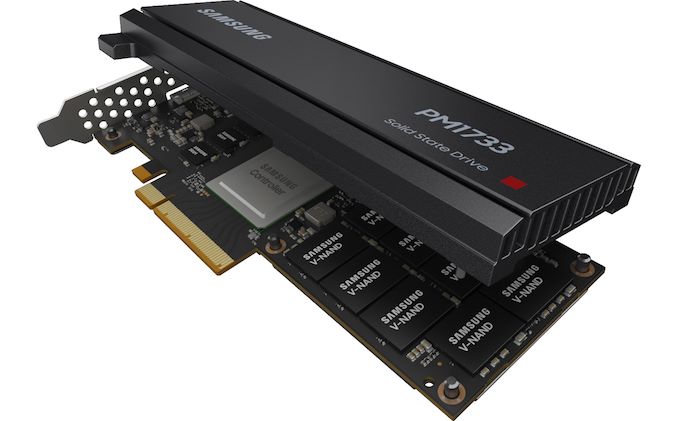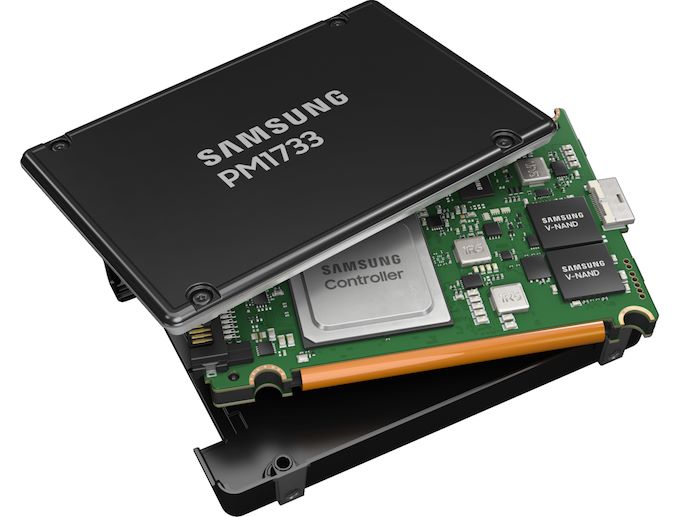Samsung Preps PM1733 PCIe 4.0 Enterprise SSDs For AMD's "Rome" EPYC Processors
by Anton Shilov on August 9, 2019 10:00 AM EST
With the launch of AMD's new second generation "Rome" EPYC processors, AMD's numerous hardware partners have been lining up to announce their own wares built around the new processors. And this doesn't just go for OEMs and integrators, but it also extends to component suppliers who have been eagerly awaiting the first x86 server processor with PCIe 4.0 support. To that end, yesterday Samsung sent out an announcement confirming that their previously announced PM1733 enterprise SSD supports AMD's new processors, and that just in time for inclusion in Rome systems, they'll be shipping this quarter.
Samsung first announced the PM1733 last fall, as part of its general SSD roadmap update for the then-forthcoming year. The PM1733 is the successor to their PM1723b enterprise SSD, and is designed to take advantage of the bandwidth advances provided by PCIe 4.0. Based on the company’s proprietary controller and paired with 512 Gb 5th Generation V-NAND memory chips, the drive family is rated for read speeds of up to 8 GB/second.
Interestingly, Samsung is offering both PCIe 4.0 x4 and x8 versions of the SSDs, with the U.2 versions using a x4 interface while the alf-length half-height (HHHL) card versions will use x8. The U.2 drives with dual-port capability will offer capacities of up to 30.72 TB, whereas the HHHL cards will carry up to 15.36 TB of useful V-NAND flash.
Overall, Samsung's focus on the drive in terms of specifications is on the drive's read performance rather than its write performance. Along with its 8 GB/sec rated sequential read speed, Samsung says the PM1733 can handle random reads of up to 1500K IOPS, which would make the PM1733 among the fastest drives announced so far.
Samsung will start shipments of its PM1733 SSDs this quarter. Among x86 platforms, the PCIe 4.0 capabilities of the drives will only be available on AMD EPYC 7002 and AMD Ryzen 3000 platforms, but the devices will also work with current PCIe 3.0 platforms from Intel and AMD. The manufacturer has not disclosed prices of the new PM1733 SSDs so far.
Related Reading:
- Samsung 30.72 TB SSDs: Mass Production of PM1643 Begins
- Samsung Launches Broad Range Of Datacenter SSDs
- Samsung Launches Energy-Efficient PM883 SSD with SATA 3.3, LPDDR4
- Samsung At Flash Memory Summit: 96-Layer V-NAND, MLC Z-NAND, New Interfaces
- Samsung Unveils 6th Generation V-NAND Memory with Up to 136 Layers
- Samsung at Flash Memory Summit: 64-layer V-NAND, Bigger SSDs, Z-SSD
Source: Samsung











44 Comments
View All Comments
ADB1979 - Friday, August 9, 2019 - link
It will happen...The main problem with PCIe 4.0 / NVMe drivers is that the only review I have read had the PCIe drive perform at almost exactly the same "real world" level as a PCIe 3.0 (NVMe) drive, this was simply because the IOPS on the the PCIe 4.0 drive were no higher, and unless you are pushing around large files you will never see the "headline" performance figures.
An analogy would be like driving a Ferrari around a busy, congested city in rush hour.
Once drives with higher IOPs, specifically at low que depths arrive they might be worth looking at, but for now they are priced at insane levels for the same "real world" performance.
An Intel (and upcoming Micron) Optane drive on PCIe 4.0 x4 could be stunning, however, Intel will not go there until Intel has PCIe 4.0 or 5.0 boards on the market (Intel might skip PCIe 4.0 and go straight for PCIe 5.0 (already ratified).
eastcoast_pete - Saturday, August 10, 2019 - link
I wonder how the performance of these compares with Intel's Optane? Samsung targeting these to EPYC systems makes a lot of sense. Might be interesting for setups that require very frequent snapshots, like high-availability databases such as HANA.schujj07 - Thursday, August 15, 2019 - link
For HANA it will only matter if a vendor decides to certify a Rome based server for it. Right now every certified HANA appliance runs Intel.eastcoast_pete - Saturday, August 10, 2019 - link
Also a minor edit: the alf-length half-height needs it's "h" back, although an " alien life form length half-height" drive might be a lot more newsworthy. Hmm, where did Samsung get those numbers for an alien's length from? I smell a massive conspiracy!